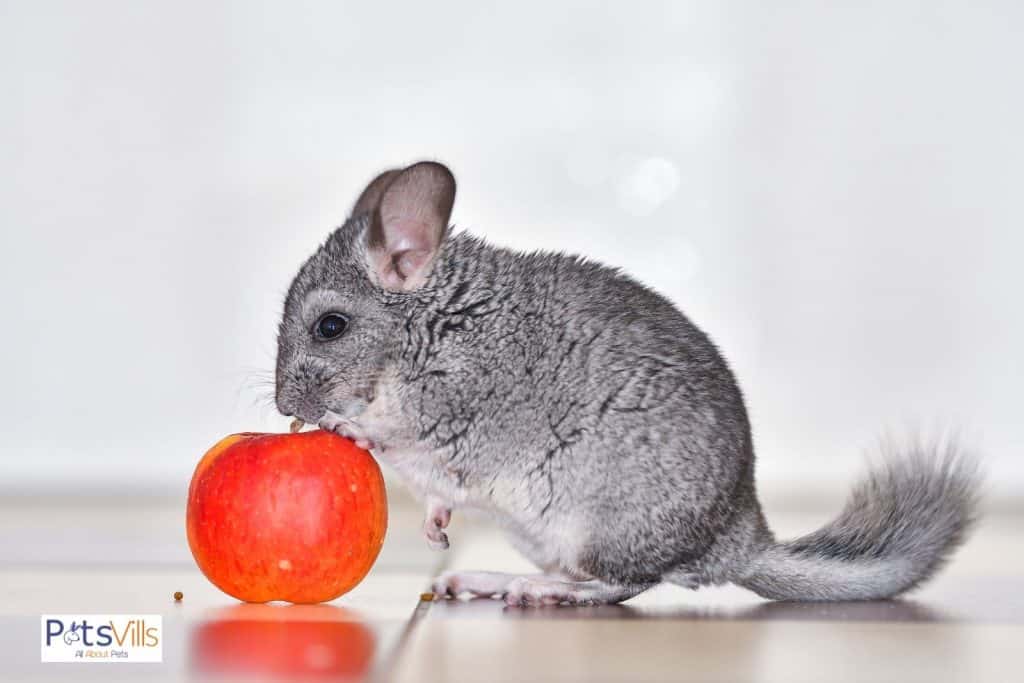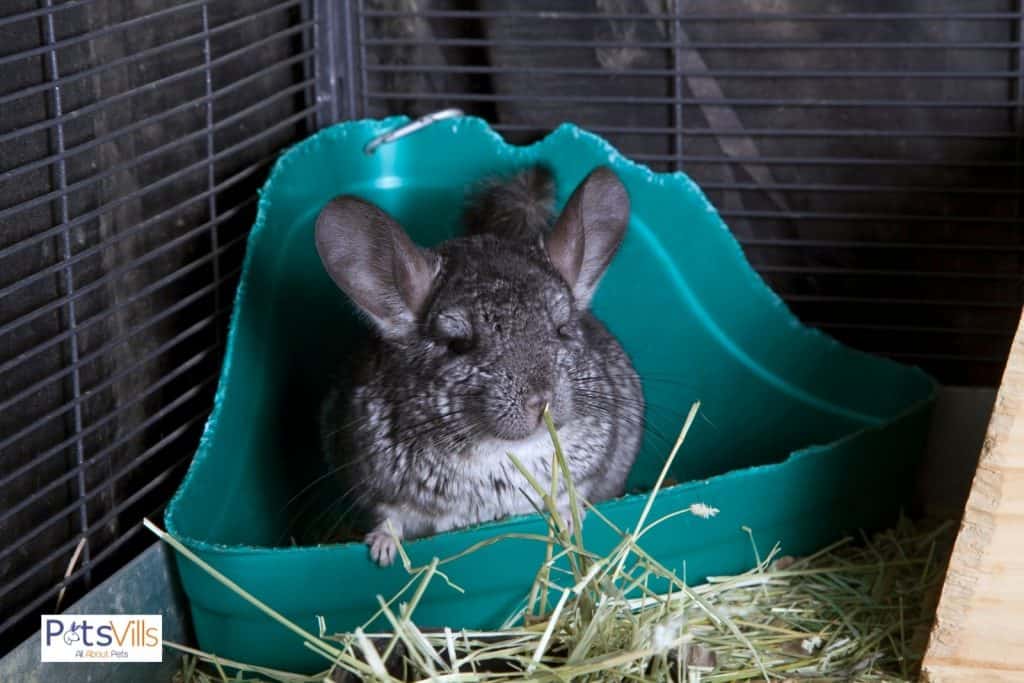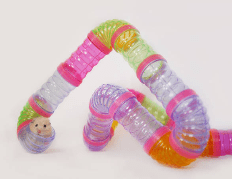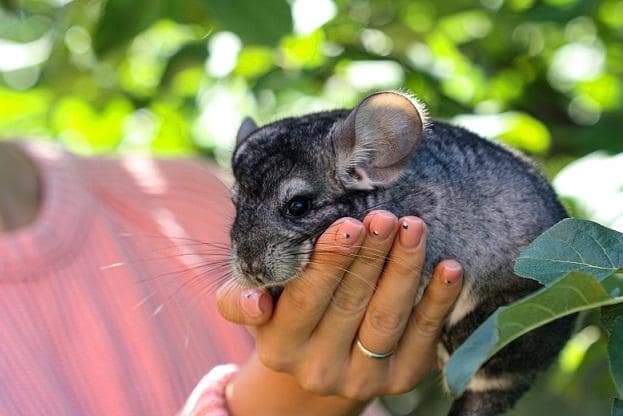Taking care of your cuddly, soft chinchilla is a unique and fulfilling experience.
However, maintaining your pet’s weight in the healthy range is important for their overall well-being.
If you’re concerned that your chinchilla might be a little on the hefty side, don’t panic.
As a chinchilla expert, I’ve put together this comprehensive article designed to help you navigate these somewhat fluffy waters.
So grab your cup of coffee and let’s dive in!
Table of Contents
Understanding Chinchilla Body Condition
“Is my chinchilla fat? Most chinchilla owners ask. Before we dive into specifics, it’s paramount to grasp the basics of a chinchilla’s physique. So, what’s the difference between a fat chinchilla and one with a robust fur coat? Let’s break it down.
Ideal Weight and Body Shape for Chinchillas
The average weight of a healthy chinchilla fat ranges between 400 and 600 grams. Anything beyond might scream “chubby chinchilla cute.” However, an individual’s age, gender, and breed can influence this. The body should be streamlined, with no protruding belly.
Signs and Symptoms of a Fat Chinchilla
A rotund chinchilla isn’t just about weight. Noticeable fat deposits, especially around the hips, are tell-tale signs. Difficulty in moving or an altered gait? That’s a chubby hint right there!
Health Risks Associated with Obesity in Chinchillas
Obesity isn’t just a human problem. Chinchillas face a slew of health issues when overweight: heart problems, liver diseases, and increased surgical risks. Not to mention a shorter lifespan.
Identifying the Causes of Chinchilla Obesity
But how does a chinchilla end up looking like it’s storing nuts for winter? While genetics play a part, other factors can be controlled to keep your chinchilla fit and fabulous.
Diet and Nutrition Factors
A chinchilla’s diet is critical. Those high-fat, sugary treats? Tempting, but detrimental in excess. Stick to a well-balanced diet tailored to chinchilla needs.
Lack of Exercise
Yes, even chinchillas need their cardio. A sedentary lifestyle will inevitably lead to weight gain. Make sure they have room to roam and explore.
Overfeeding and Incorrect Portion Sizes
More isn’t always better, and a fat cute chinchilla is not always “cute”. Avoid piling up the food bowl. Instead, offer moderate portions, ensuring your pet doesn’t overindulge.
Genetics and Predisposition to Weight Gain
Some chinchillas are genetically inclined to gain weight. While you can’t change genes, you can counteract with a suitable diet and ample exercise.
Assessing Your Chinchilla’s Body Condition
Knowing is half the battle. Regular assessments ensure you spot any weighty problems early on. Let’s zoom in on some effective evaluation methods.
Conducting a Visual and Hands-On Examination
Trust your eyes and hands. A bulging abdomen or difficulty feeling the spine might suggest your chinchilla is on the plumper side.
Utilizing Body Condition Scoring Systems
Veterinarians often use scoring systems to rate chinchilla body conditions. Familiarizing yourself with these can offer invaluable insights.
Monitoring Weight and Changes Over Time
Weigh your chinchilla regularly. Yes, a fat cute chinchilla is cute but not healthy. But, sudden weight gain (or loss) warrants a deeper look into their health and diet.
Developing a Healthy Diet and Feeding Routine
Ensuring your chinchilla leads a healthy lifestyle begins with their plate—or, in this case, their feeding bowl.
Just like humans, a balanced diet is pivotal for these fluff balls. Ready to dive deep into the delightful world of chinchilla nutrition? Let’s nibble away!

Determining the Right Nutritional Requirements
Every chinchilla, regardless of its cheeky personality, requires specific nutrients to thrive. High fiber, low fat, and just the right amount of protein make the ideal diet. Understanding and balancing these elements ensures our chinchilla friends remain spry and lively.
Selecting Appropriate Chinchilla Pellets and Treats
Quality over quantity should be your mantra. When selecting pellets, opt for those without unnecessary additives or fillers. And when you feel the urge to treat your furry companion?
Remember, natural treats like dried rose hips or hibiscus flowers are far better than sugary temptations.
Incorporating Fresh Hay and Fibrous Foods
Hay should be the mainstay of a chinchilla’s diet, promoting dental health and providing essential fiber. Timothy Hay, in particular, is a fan favorite. Pair this with occasional fibrous veggies, and you’ve got one happy muncher!

Managing Treats and Snacks Moderately
Ah, the allure of treats! While those sparkling chinchilla eyes are hard to resist, moderation is key. Overindulgence can quickly turn a svelte chinchilla into a chubby one. Reserve those special tidbits for occasional rewards.
Encouraging Exercise and Physical Activity
A chinchilla’s innate energy is like that of a caffeinated squirrel – always bustling and ready to explore!
Channeling this energy into productive physical activities is not just about preventing a fat chinchilla, but it’s also about ensuring mental stimulation and overall well-being. Let’s jump right in!
Providing a Spacious and Stimulating Cage Environment
Space to move is a chinchilla’s dream. A roomy cage allows them to jump, dart, and stretch at will. Ensuring their home has different levels, nooks, and hideouts can pique their curiosity and encourage exploration.
Offering Chinchilla-Safe Toys and Enrichment Activities
Toys aren’t just child’s play! Offering chinchilla-safe toys can keep your fluffy friend engaged. Think wooden chews, or hanging toys that challenge their nimble paws.
Activities that stimulate both their mind and body will keep boredom at bay.

Creating an Exercise Routine and Playtime
Consistency can boost a chinchilla’s fitness levels. Designate daily playtimes outside the cage, under supervision. This not only strengthens your bond but also lets them explore and exercise in a broader space.
Utilizing Chinchilla Wheels and Climbing Structures
Remember, chinchillas aren’t hamsters. If opting for a wheel, ensure it’s chinchilla-sized and solid floor. Climbing structures, ladders, or branches can provide vertical challenges, mimicking their natural mountainous habitats.
Implementing Weight Management Strategies
Facing a fat chinchilla scenario? Don’t fret! Implementing an effective weight management strategy is entirely doable. The key? A pinch of patience, a dollop of expert advice, and a generous sprinkle of monitoring.
Gradual Weight Loss Plans and Goals
Quick fixes are not the solution. Instead, think gradually. Set realistic weight loss targets over time, ensuring your chinchilla’s well-being isn’t compromised. Small, consistent changes in diet and activity can yield significant long-term results.
Consultation with a Veterinarian for Guidance
Before diving headfirst into a weight management journey, always consult a veterinarian. They can offer tailored guidance, ensuring the weight loss plan is both safe and effective. Remember, each chinchilla is unique; what works for one might not suit another.
Tracking Progress and Adjusting Diet and Exercise
Monitoring is crucial. Regularly weigh your chinchilla and note the progress. If the scales aren’t budging, it might be time to tweak the strategy. Adjustments in diet portions or exercise routines can make a world of difference. Stay flexible, and respond to your pet’s needs.
Recognizing Signs of Fat Chinchilla
A fat chinchilla isn’t just about appearances. Obesity brings a host of health issues. Stay vigilant, recognizing signs early on.
Dental Problems
Chinchillas possess continuously growing teeth, and a fat chinchilla can sometimes neglect the crucial act of grinding them down. Overweight chinchillas often develop dental complications, from overgrown incisors to misaligned bites.
The result? Difficulty eating, drooling, or even facial abscesses. Regular dental checks can prevent these complications and ensure their pearly whites remain in tip-top shape.
Gastrointestinal Issues
A chinchilla’s diet needs to be fibrous, promoting smooth digestion. However, obesity can hamper their digestive efficiency, leading to a plethora of gastrointestinal issues. Constipation, diarrhea, or unusual droppings?
These can be warning signs. An optimal diet and weight can keep their tiny tummies trouble-free.
Respiratory Infections
Labored breathing or noticeable fatigue during light activities can signal respiratory issues in chinchillas. Excess body fat exerts pressure on the diaphragm, making it harder for them to breathe.
Keep an ear out for wheezing or coughing, as these might indicate underlying respiratory infections exacerbated by weight issues.
Skin Conditions
More fat can result in increased skin folds and creases. These areas are breeding grounds for bacterial or fungal infections due to moisture accumulation. Regularly inspect your chinchilla’s skin.
Redness, swelling, or unusual odors should warrant immediate attention to prevent severe skin conditions.
Behavioral Changes
A fat chinchilla might exhibit a shift in behavior. From the once active, curious explorer, they could become lethargic, showing reduced interest in play or interaction.
Additionally, they might avoid certain activities that they once enjoyed, simply because their weight makes them more challenging.
Preventing Chinchilla Obesity in the Long Term
Prevention, they say, is better than cure. And it’s true. Here’s how you can ensure your chinchilla stays fit throughout its life.
Maintaining Consistency in Diet and Exercise
Consistency is key. Establish a regular feeding routine with high-quality, fibrous foods. Couple this with daily exercise sessions, ensuring your chinchilla gets its essential movement and play.
Regular activities can keep that extra fluff at bay.
Regular Veterinary Check-ups and Monitoring
Schedule periodic vet visits. This proactive approach not only ensures weight management but also identifies potential issues early on. Regular weigh-ins, perhaps using a simple kitchen scale, can monitor any unexpected weight fluctuations.
Educating Yourself on Chinchilla Health and Care
Knowledge is power. Continually educate yourself about chinchilla health. The more you know, the better equipped you’ll be to notice changes and act accordingly. With countless resources available, from books to online communities, staying informed has never been easier.
Conclusion
Navigating the world of chubby chinchillas might seem daunting. But equipped with the right knowledge and tools, you’re set to ensure your fluffy companion remains healthy and active.
So, here’s to many more years of delightful, fit, and furry memories!
FAQs
How can I tell if my chinchilla is overweight?
Check for fat rolls, and difficulty in mobility, or compare their weight to the standard weight range for chinchillas.
What should be the primary component of a chinchilla’s diet to avoid obesity?
The primary component should be high-fiber hay, specifically Timothy hay, complemented by nutrient-rich pellets.
How often should I exercise my chinchilla to keep it in shape?
Allow your chinchilla supervised playtime outside its cage daily to promote regular exercise and mental stimulation.
Alina Hartley is a small-town girl with a ginormous love of bearded dragons. It all started with Winchester, a baby bearded who was abandoned at the shelter by his former owners because of a birth defect that caused one front leg to be shorter than the other. Alina originally went to the shelter looking for a guinea pig, but one look at Winchester and it was love at first sight. From that day on, Alina has dedicated her life to learning everything she can about bearded dragons. She loves helping new beardie parents start their incredible journey with these magnificent reptiles.
Follow her on:
LINKEDIN
TWITTER.
Read her latest articles HERE
Learn more about her HERE.

